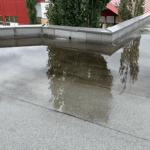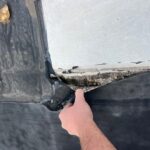The 2016 roofing season is about to begin and some experts believe the anemic construction recovery could be offset by the repair market due to this past winter’s ice, wind and tree damage. With OSHA’s continued enforcement of Compliance Guidance for Residential Construction (STD 03-11-002) requiring residential contractors to comply with its Fall Protection Standard (Subpart M, 1926.500), the use of personal fall arrest systems (PFAS) must inevitably increase. The roofing contractor’s duty to provide fall protection includes providing prompt self, assisted or technical rescue measures for employees should an arrested fall terminate in a suspended position. Rappelling and auto-lowering retractable lifelines are two common methods for self-rescue (SR) for roofers. Assisted rescue (AR) procedures may include trained and drilled rescue measures by coworkers using portable ladders and aerial lifts. High-angle, technical rope rescue services (TR) may be provided by either a third-party fire department or emergency response team for more complicated or extreme height rescues. The most critical component of all three of these rescue plans is the victim’s ability to prevent the onset of the syncope (faint) cycle while either participating in or waiting for a rescue.
It’s critical that the employer becomes familiar with the engineering, administrative, personal protective equipment and life-support practices available to employees who may accidentally fall in a PFAS. If the system works as designed, every employee who experiences a fall arrest may encounter a maximum deceleration force of 1,800 pounds on the torso (harness-induced pathology, or HIP). This terminal impact force (TIF) is equivalent to driving head on into a concrete bridge abutment at 14.8 miles per hour while wearing a seatbelt. While HIP may initially precede the syndrome of suspension trauma (ST), it may contribute greatly to the rapid onset of ST symptoms.
Our bodies are intolerant of being suspended vertically motionless for a prolonged length of time. All five liters of our total blood volume can be pulled by gravity into the distended veins of our legs within 15-20 minutes post arrest. As the brain loses oxygen it will initiate a syncope, intended to make the body collapse to a horizontal posture, where the blood pressure is equalized and free to flow back to the heart. If the suspended victim is prevented from reaching a prone position during the first faint episode, the brain will initiate a second, and much deeper, syncope, ensuring the victim falls into a horizontal recovery posture. Vertically restrained, the victim can’t fall to a horizontal posture. The third and final and syncope usually proves fatal.
There are a number of physical and biological conditions in the post-arrest fall victim which can prevent the blood from returning to the core organs (heart, lung and brain) in time to prevent this faint cycle. Physical conditions may include double tourniquets created by the two harness leg straps or internal/external blood loss from groin impact injury. Common biological conditions include dehydration, systemic acidosis, interstitial plasma diffusion and pervasive deep-vein thrombosis. Depending on systemic shock or physical injury incurred as a result of the fall, self-rescue may not be advisable, as the rescuer is also the diminished victim. Without proper training and equipment, a rooftop-assisted rescue may not be feasible. Suspended 20 to 200 feet above a disorganized ground-based rescue effort, the arrested victim has few options but to wait for technical rescuers. But time is precious. Not a minute should be wasted on anything but survival. The following equipment and techniques are recommended to help prevent the onset of suspension trauma in the suspended worker:
Relief Straps: There are dozens of manufacturers of relief straps in the fall-protection market today. They are all designed to be used to reduce your body’s weight off of your leg straps and redirect it into single or double webbing stirrups, rigged directly to your PFAS. This assists the post-arrested victim to possibly loosen (not disconnect) the leg straps, allowing the collapsed femoral vein to reopen for circulation back to the heart. I have tested many of these products and rigged my own, using triple Prusik knots in webbing loops tied to a 5/8-inch lifeline. Although some relief-strap designs may be more efficient or convenient to use than others, none of them provide a perfect solution. The pain, disorientation and confusion incurred after even a minor fall can contribute to the immediate and pervasive exhaustion involved with every aerial self-rescue effort. For this reason alone, self-rescue plans should include extensive, evolutionary drills for every employee assigned to wearing PFAS. If your first drill is your first emergency fall, the results will inevitably be disappointing. As with all other faint-protection techniques noted here, once you initiate implementation, you should diligently continue every effort to reestablish blood circulation, unless you suspect the effort may cause an initial faint from either exhaustion, pain or panic. Unfortunately with ST, fainting is a cycle that will continue as long as you’re restrained. Until the rescue team reaches you or you descend to grade, you remain alone and solely in charge of your life.
Hammock Position: If you are within 24-inch proximity to your 5/8-inch nylon lifeline after your fall, you may reach down to your ankle height and grab the line with one hand. Pull the unloaded tail up to your chest and tie an overhand loop in the line approximately 18 inches in diameter. When this loose line is dropped, it should provide a raised stirrup into which you can stand for a short period while loosening your leg strap (tourniquet) off of your femoral vein. Repeat the operation on the opposite leg. Gently lower your weight back onto the loosened leg straps with both feet in the loop, loading the tail line. Grip the lifeline with both hands and pull it toward your chest. This operation will raise both legs slightly, improving circulation. Drilling this exercise while harnessed in a tripod will give your employees the experience of the physical efforts required to sustain blood circulation until rescued.
Leg Pulls: If a relief strap or vertical lifeline are unavailable, the leg pull is the next most effective method to restore blood circulation. Located every 20 centimeters inside the veins of the legs and arms are small, tricuspid valves. Each beat of the heart raises the systolic pressure in the veins, pushing the blood up to the next valve. As the diastolic pressure drops, the blood falls and closes the valve below. Thus, the venal blood climbs the legs, similar to a series “fish ladder†pools bypassing a dam. The route of the femoral vein in the lower and upper leg passes between muscle-to-muscle or muscle-to-bone anatomy. Without muscle walls in the veins, every contraction of the leg muscles causes compression of blood, forcing it up to the next check valve. This muscle-pump mechanism generated by leg pulls may successfully return blood volume to the heart. Reach behind your back with your hand and grab your pant cuff. Then with your arm strength, gently, but steadily, pull up on the cuff, bending the lower leg at the knee up to your buttocks. Repeat this process three times in front and then reverse it to the other leg. Being 15-20 degrees from vertical hang position, continuous spinning and any fall-induced groin injury will definitely compound the difficulties encountered with this operation, but it’s very efficient at moving large volumes of blood around the bi-lateral tourniquets.
Toe Kicks: When every other technique proves either infeasible or eventually fails, there is one self-rescue method still available to the victim, regardless of age, conditioning or training. With the same debilitating, post-arrested fall conditions as mentioned in the Leg Pull method, the Toe Kick can be the simplest to perform, and thereby perhaps the most effective. You should first stabilize your torso by grabbing the harness’s elongated shoulder straps with both hands. Next, from the not-quite-vertical hang position, forcibly kick one foot forward and down, pointing the toe and straightening the leg. This tightens the muscles of the foot, calf and thigh for a second or two, pumping the venal blood to the next valve. While relaxing the first leg, kick the second leg into a rigid toe-point for a three-second hold. While simple to perform, this procedure can be exhausting as well. Any harness-induced injury to the groin during arrest can also prove painful during toe kicks. I suggest you keep time with each toe kick to your favorite song. Repeat until it’s no longer your favorite.
Head Rest: Considering the discomfort of the less-than-vertical, spinning hang position the victim finds himself in after arrest, the tendency is to raise your head to a vertical position with line of site toward the horizon. This bends the cervical vertebrae back and hyperextends the muscles of neck. Over several minutes, the contracted muscles tend to distend and compress the carotid artery leading to the brain. As arterial oxygen levels drop and venal toxic acids rise, the brain may initiate the syncope cycle minutes earlier. To prevent this, grab a shoulder strap with the opposite hand, bending the arm at the elbow, producing a shelf on which to rest the 10 pounds of skull/fluid/brain weight. With two fingers of the other hand, gently massage the strained neck muscles behind the mandible on that side, allowing them to relax as the head’s weight is transferred from neck to arm. Reverse the operation for the opposite side of the neck until the weight of the head is resting entirely on the arm.
As with any rescue technique, the self-rescuer’s age and overall physical condition play an important role in the timing and success rate of operations. The employer should always consider annual physicals with a licensed medical professional as mandatory for anyone considering self, assisted or technical high-angle rope rescue as an option. As members of the International Industrial Rope Access Trade Association (IRATA) know well, there are no sure things when it comes to aerial work or rescue. Planning is essential before climbing, and it takes more than one self-rescue practice drill to ensure success. But whatever else you believe may happen to you after an arrested fall off of a roof, your survival will ultimately depend on the confidence developed through training and drills.
Courtesy of Roofing Contractor Magazine





